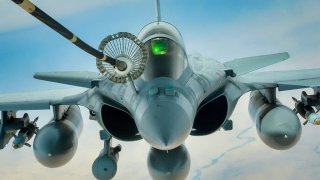Dassault Rafale: The Fighter Plane Every Air Force Would Love to Fly
France's Rafale fighter jet, designed in the 1970s to meet the needs of both the French Air Force and Navy, is experiencing a resurgence in popularity, outpacing the demand for the newer American-made F-35.
Summary: France's Rafale fighter jet, designed in the 1970s to meet the needs of both the French Air Force and Navy, is experiencing a resurgence in popularity, outpacing the demand for the newer American-made F-35. Despite its age, the Rafale remains a favorite in the Middle East, India, and Eastern Europe, largely due to geopolitical tensions. Its versatile capabilities, reduced radar and infrared signatures, and advanced avionics make it a competitive choice. Currently, countries like Serbia are moving to replace older Russian aircraft with the Rafale, highlighting its strategic appeal. The jet's success on the market, driven by its affordability and France's neutral stance in global conflicts, positions Dassault Aviation to potentially increase its profits if it can manage supply-chain challenges.
Dassault Rafale Jets Surge in Global Demand as Countries Seek Advanced Yet Cost-Effective Fighter Solutions
The most sought-after fighter today is surprisingly not the American-made fifth-generation F-35 stealth platform. Rather, interest is surging in France’s Rafale jet so much so that the manufacturer Dassault Aviation may not be able to meet demand.
The twenty-plus-year-old platform is particularly coveted in the Middle East, India, and Eastern Europe, where countries seek to boost their air forces amidst rising geopolitical tensions across the board. Most recently, Serbia signaled that it was close to finalizing a deal to procure a dozen of these French jets. This potential purchase is significant considering the nation’s previous reliance on Russian-made platforms. Today, export orders for the Rafale total 261 new airframes from customers, including Egypt, the United Arab Emirates, Indonesia, and India. Why is this aging jet doing so well on the market?
The History of the Rafale Fighter
Back in the 1970s, France’s Air Force and Navy were both seeking replacement platforms for their respective aging airframes. Since the requirements of both services were similar, the country’s Ministry of Aviation opted to green-light the development of a single platform capable of fulfilling each branch’s defense needs.
Italy, Spain, West Germany, and the United Kingdom jumped on board, establishing the Future European Fighter Aircraft joint program between these countries.
The resulting Eurofighter Typhoon was a powerful platform. However, the French government continued to work on its own homegrown program simultaneously.
Specifics & Capabilities
The Rafale was designed to carry out the roles previously filled by an array of aircraft, including the Mirage, F-8P Crusader, Jaguar, and Super Etendard. Since local developers manufactured the Rafale, the platform exemplified France’s capacity to build fighters.
The formidable jet was developed to perform aerial reconnaissance, air supremacy, ground support, interdiction, and other mission sets. In terms of armaments, the French airframe is equipped with payloads of more than nine tons on fourteen hardpoints, including HARM, Apache, Maverick, and PGM-100 air-to-ground missiles, as well as ASRAAM and AMRAAM air-to-air missiles.
While the Rafale is not considered a fully stealth platform, the French airframe was designed with a reduced radar cross-section and infrared signature, which makes it more challenging for enemy airframes to detect. Advanced avionics and other equipment also help the fighter retain an edge over competitors.
Integrated Modular Avionics (IMA) is incorporated into the platform, greatly assisting combat operations via data fusion. SPECTRA, a sophisticated integrated defense system, also helps the platform defend against airborne and ground threats.
Considering the Rafale’s versatility and cheaper associated costs as compared to newer fifth-generation platforms, the jet’s popularity makes sense. The United States and Russia are also embroiled in conflicts and tension over Ukraine, the South China Sea, and the Middle East, perhaps making France seem like the airframe supplier easiest to deal with at the moment.
If Dassault can sort out its supply-chain issues, France could profit wildly from the Rafale’s current popularity.
About the Author: Maya Carlin
Maya Carlin, National Security Writer with The National Interest, is an analyst with the Center for Security Policy and a former Anna Sobol Levy Fellow at IDC Herzliya in Israel. She has by-lines in many publications, including The National Interest, Jerusalem Post, and Times of Israel. You can follow her on Twitter: @MayaCarlin.
Image: Shutterstock.


